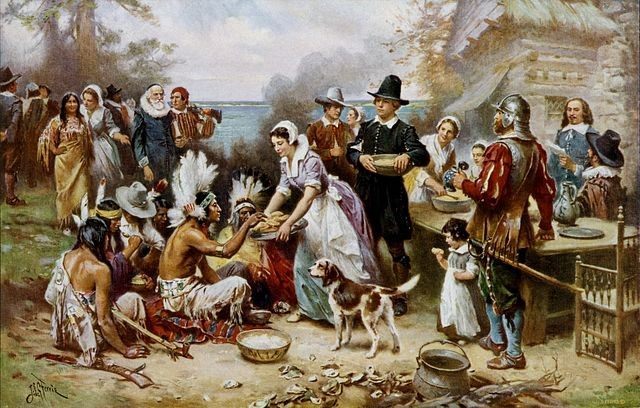The Pilgrims suffered a 60 percent death rate in their first year at Plymouth. The remaining 53 Pilgrims and 90 locals celebrated “Thanksgiving,” because their losses were actually relatively low.
Having arrived via the Mayflower in 1620, only 53 remained of the 132 passengers were still alive by the fall of 1621. The survivability of the Pilgrims was considered a great accomplishment, since England’s supposedly successful colony in Virginia had suffered an 85 percent loss rate, with 6,800 of the 8,000 arrivals dying between 1607 and 1625, according to Stratfor Global Intelligence.
The Thanksgiving celebration over the three-day harvest feast was in recognition of the English plantation’s small step toward stability and potential profitability. Despite outrageous levels of attrition during their first years, English pilgrims and adventurers kept coming to North America and the government and business leaders kept funding them.
The biggest reason for support for colonization was England’s internal instability over economics and religion that eventually resulted in the 1642 civil war, followed by the Republican overthrow and execution of King Charles I in 1649.
The 17th Century religious disputes centered on the Church of England’s “high” practices, which involved elaborate rituals that were similar to the Catholic Church. The religious disputes compounded a political crisis that pitted Parliament’s power to grant the King funds needed for war and debt payments against the King’s power to call Parliament into session and dismiss it. The Puritans were at the center of advancing Parliament’s power.
The Thirty Years’ War broke out in 1618 in Germany, mostly about the conflict between Protestants and Catholics. The war spread throughout Central Europe. King James tried to avoid involvement, but Puritan factions in Parliament wanted England to strike at Catholic Spain’s wealth shipments from the Americas. In 1625, James antagonized Puritans by marrying his son Charles to the Catholic daughter of the King of France.
Puritan leaders in Parliament, who would later play a pivotal role in the English Civil War, supported establishing a set of Puritan colonial ventures in the Americas to undermine Spain’s colonial empire and enrich England. The effort was a continuation of Elizabeth I’s strategy in 1585, when she authorized British ships to act as pirates to raid and capture Spanish treasure ships in the Atlantic and Caribbean.
Although the Plymouth and Massachusetts Bay colonies were part of the Puritans’ effort to challenge Catholics, they proved too remote to challenge Spain’s focus on the Caribbean. But their remote location and poor climate also meant that it was not worth the effort for the Spanish to raid New England, according Stratfor.
Spain’s New World colonies since 1520 had been sending increasing amounts of silver and other precious metals home to the mother country, which had previously been a resource-poor nation. The new wealth had made Spain the dominant power in Europe and the world.
Despite the English and Dutch Protestants not establishing successful colonies until the 17th century, their northern New World colonies would open huge trading opportunities. By the middle of the 17th century the Protestant nations had become strong naval powers and the Dutch merchant fleet was larger than all the other European fleets combined.
Lacking the spectacularly large Aztec, Mayan and Inca tribes the Catholic Spanish and Portuguese had enslaved as workers in Mexico, Central and South America, the Protestants’ colonies relied largely on labor migrating from Europe. As a result, Protestants eventually gained a demographic advantage that led to their New World dominance.
Plymouth stood alone as an unprofitable New England colony for a decade. But by 1640, there 11,000 English in the area. Although the Pilgrims wanted to establish a separate Godly society to escape persecution, the Puritans also wanted economic success, and saw it as a sign of Divine favor.
The Puritan colonies became a replica of English political life and a key regional component of the Thirteen Colonies. Originally centered on an agrarian society based on individual farmers and families, New England later became the United States’ early manufacturing power.
As the United States celebrates Thanksgiving, we all should remember the risks and sacrifices of the Pilgrims 395 years ago.

COMMENTS
Please let us know if you're having issues with commenting.